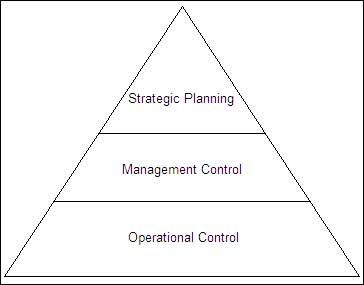In order to understand the importance of MIS one must understand and appreciate the role that MIS plays in an organization. An organization may be conceived in a lot of ways. One can visualize an organization as a balance sheet or a function of financial statements, i.e., as a financial entity or as an organization chart delineating the decision-making hierarchy levels and formal communication channels. While both views are correct, the latter view is more appropriate for understanding an organization’s MIS.
Anthony in his seminal work elaborated (R.A. Anthony 1965) on this view of an organization as its hierarchy of decision-making. He focused on the managerial aspects of an organization and classified the management process into three distinct levels.
We’ll be covering the following topics in this tutorial:
Strategic Planning
This requires focusing on the objectives and goals of the organization, on changes in the objectives, on the resource requirements to fulfill the objectives and on the guiding principles and policies that will govern the acquisition, use and disposal of resources to attain the objectives. In short, this role is the most important role in the management hierarchy and the decisions taken by managers in this role have a far-reaching impact on the organization. Managers in this role set the direction in which the organization will travel. In terms of hierarchy, this lies at the top.
Managerial Control
This requires that resources are acquired and used effectively and efficiently to attain the objectives of the organization. This is a middle management role. Managers in this role take guidance from the strategic planning hierarchy and control the activities of the organization such that the goals set by the higher level are attained in an efficient and effective manner. The impact of the decisions of the managers in this role is medium term and degree.
Operational Control
This requires that directives as set by the immediate higher hierarchy is followed and that specific task/s are carried out effectively and efficiently. The decisions at this level have very little impact on the organization. The organization behaves in a routine nature where the parameters of the decision-making process are well laid and certain.
Anthony’s idea of an organization’s hierarchy from the perspective of managerial activities. As is clear, it is a three-level pyramid with very distinct levels. Each level has its own set of tasks and decisions to take which have a varying impact on the organization as a whole.

Management Levels in Organizations
Management Function | Strategic Planning | Management Control | Operational Control |
Planning | Long-range, high impact | Medium range, medium impact | Short range, low impact |
Organizing | General framework | Departmental level | Small unit level |
Staffing | Key senior people | Medium level, tactical level | Operational level |
Directing | General and long range directives | Tactics | Routine activities |
Controlling | Aggregate level | Periodic control and controlling exceptions | Regular and continuous supervision |
For example, if we want to classify the decisions of a manufacturing firm, the strategic planning will encompass the annual production planning, annual budgeting, setting up of new plants and/or installation of new machinery to upgrade the production process and other such activities. Management control activities would include monthly production planning, maintenance planning and scheduling. Operational control on the other will deal with routine daily tasks of managing and supervising shifts to exercise control over the process so that the monthly plans and schedules as made by the management control level managers are met.
 Dinesh Thakur holds an B.C.A, MCDBA, MCSD certifications. Dinesh authors the hugely popular
Dinesh Thakur holds an B.C.A, MCDBA, MCSD certifications. Dinesh authors the hugely popular